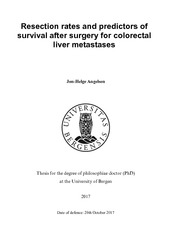| dc.contributor.author | Angelsen, Jon-Helge | en_US |
| dc.date.accessioned | 2018-02-07T15:49:52Z | |
| dc.date.available | 2018-02-07T15:49:52Z | |
| dc.date.issued | 2017-10-20 | |
| dc.identifier.isbn | 978-82-308-3950-8 | en_US |
| dc.identifier.uri | https://hdl.handle.net/1956/17351 | |
| dc.description.abstract | Introduction: Occurrence of liver metastases is common following colorectal cancer (CRC), and resection is the only option with a potential for cure offered to a minor part of these patients. During the last decades there have been major improvements in the oncosurgical treatment, along with expansions in inclusion criteria for surgery. The majority of the patients will unfortunately experience post-resection recurrence. Divergent results have been presented regarding the need of clear resection margins (RMs) to accomplish an optimal outcome. Data on national resection rates in patients with CLM are sparse. Aim of the thesis: I: To study RMs and the correlation with local recurrence (LR) pattern, time to recurrence (TTR) and overall survival (OS) in patients resected for CLM. II: To study patterns of recurrence, and post-recurrence survival (PRS) according to sites of recurrence following resection for CLM. III: To study resection rates in patients diagnosed with CLM in Norway, focusing on characteristics like age, geographical regions and primary tumour. Methods: Paper I and II are based on a combined retrospective (1998-2008) and prospective (2009-2012) retrieved database of consecutive patients treated with resection for CLM at Haukeland University Hospital. Paper III is based on synchronized data from the Norwegian Patient Registry (NPR) and the Cancer Registry of Norway (CRN) where patients with a diagnosis of CRC (ICD-10: C18-20) and liver metastases (C78.7) were enrolled (2011-2013). Cumulative resection rates (CRR) following CLM were retrieved from any registration of hepatic resection (NCSP: JJB) in the data set. TTR, OS and CRR (paper I-III) were obtained using Kaplan Meier method with Log-rank test (univariate) and COX regression analysis (multivariate). All the studies were accepted by the Regional Committee for Medical and Health Research Ethics (REKVest). Results: A total of 242, 311 and 2960 patients were enrolled in paper I, II and III, respectively. In paper I the patients were grouped according to the width of the resection margins; <1 mm/R1 (n = 48), 1 to 4 mm (n = 77), 5 to 9 mm (n = 46) and ≥10 mm (n = 71). LR was significantly higher in patients with RM <5 mm. A significant difference in OS was discovered between RO and R1 (univariate), and was nearly verified in the multivariate analysis (p = 0.067). Neoadjuvant chemotherapy did not alter this finding. In paper II a total of 209 patients (67.4 %) developed recurrence after a median of 4.2 years, and were further stratified between sites; hepatic (n = 90), extrahepatic (n = 59) and both (n = 60). Median TTR and OS were 14 and 45 months, respectively. Synchronous disease, ASA score, increased number and size of metastases were all independently correlated to a reduction in TTR. Hepatic TTR was influenced by synchronous disease, multiple lesions, ASA score and R1 resections, while extrahepatic TTR was correlated to lymph nodes positive of the primary, size and number of metastases. Perioperative chemotherapy increased TTR and OS in the multivariate analysis. Single site recurrence in liver or lungs was most common and with a potential for longevity. In paper III a total of 20 % (CRR) of the patients with CLM in Norway were resected. In the multivariate analysis the resection rates varied according to age, extrahepatic metastases, disease-free interval and geographical region. In patients diagnosed with CLM, resection doubled the chance for survival. The 3-year survival after resection was 73.2 %. In the region with the highest CRR, the lowest OS was observed after resection. However the highest OS in the whole cohort of patients with CLM was obtained in this region. Conclusion: Positive margins were correlated to adverse outcomes, and were not influenced by preoperative chemotherapy. RMs <5 mm increased the risk for LR. Number and size of metastases, ASA score, synchronous disease and perioperative chemotherapy influenced time to recurrence. Single-site recurrence had a potential for longevity through repeated resections and multimodal treatment. One in five patients with CLM in Norway are offered resection, depending on geographical regions, age and disease advancements. | en_US |
| dc.language.iso | eng | eng |
| dc.publisher | The University of Bergen | eng |
| dc.relation.haspart | Paper 1: Angelsen JH, Horn A, Eide GE, Viste A. Surgery for colorectal liver metastases: the impact of resection margins on recurrence and overall survival. World journal of surgical oncology 2014;12(1): 127. The article is available at: <a href="http://hdl.handle.net/1956/8669" target="blank"> http://hdl.handle.net/1956/8669</a> | en_US |
| dc.relation.haspart | Paper 2: Angelsen JH, Viste A, IM Løes, Eide GE, Hoem D, Sorbye H, Horn A. Predictive factors for time to recurrence, treatment and post-recurrence survival in patients with initially resected colorectal liver metastases. World Journal of Surgical Oncology 2015; 13:328. The article is available at: <a href="http://hdl.handle.net/1956/12607" target="blank"> http://hdl.handle.net/1956/12607</a> | en_US |
| dc.relation.haspart | Paper 3: Angelsen JH, Horn A, Sorbye H, Eide GE, Loes IM, Viste A: Population-based study on resection rates and survival in patients with colorectal liver metastasis in Norway. The British journal of surgery 2017 Apr; 104 (5):580-89. The article is available in the main thesis. The article is also available at: <a href="https://doi.org/10.1002/bjs.10457" target="blank"> https://doi.org/10.1002/bjs.10457</a> | en_US |
| dc.title | Resection rates and predictors of survival after surgery for colorectal liver metastases | en_US |
| dc.type | Doctoral thesis | |
| dc.rights.holder | Copyright the author. All rights reserved | |
| dc.identifier.cristin | 1504412 | |
